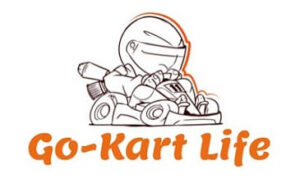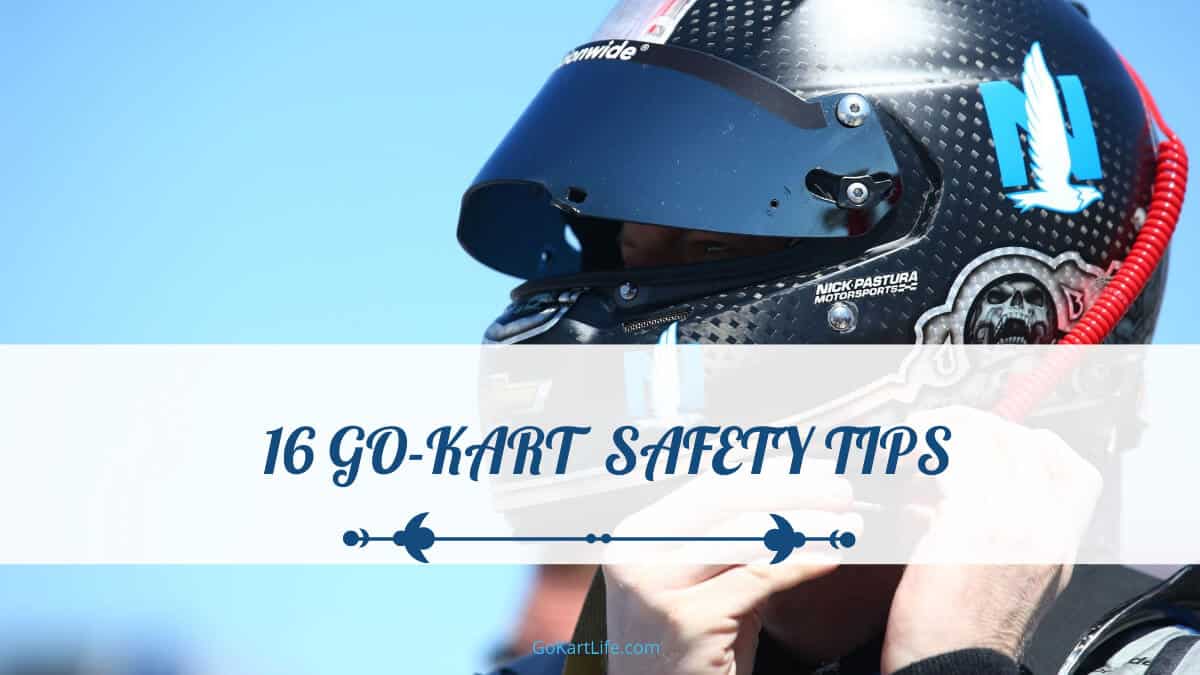Many professional Formula One racer got their start on the go-kart track. As with any thrill, though, racing go-karts comes with risk, so knowing how to keep yourself safe behind the wheel is essential.
There are many safety tips to remember while go-karting, from respecting the vehicle and wearing the proper personal protective equipment to having a solid understanding of the race area.
16 Go-Kart Safety Tips
When preparing for your next turn on the track, it is essential to remember that you cannot be too safe. As unlikely as an accident may seem, it is better to look back after the fact and say, “I didn’t even need that,” instead of “I wish I would have done that.”
Following the 16 go-kart safety tips listed below, your go-karting experience never has to be marred by regret.
1. Remember That Go-Karts Are Not Toys
As elementary as it may seem, the best way to avoid accidents on the go-kart track is to give the kart the respect it deserves.
Remember that speed in any shape or size can lead to damage, even if your kart is small and seems harmless. Some go-karts can exceed 100 miles per hour, with an accident or mishap occurring at such velocities sure to cause a catastrophe.
If you go to the track ready to have fun but are also aware of your seemingly small buggy’s capabilities, you are sure to leave with a smile on your face.
2. Wear a Helmet
Fortunately, all commercial tracks require participants to wear a helmet before entering the kart, as roughly 12 percent of all karting injuries occur to the head or neck. Therefore, even if you drive on a private raceway, you must follow this mandate and don a helmet.
The brain is among the most fragile parts of the body, with even the most minor jostling inside the skull a threat to cause a concussion. When the high speeds of kart racing are considered, it is easy to see how the head is at risk of taking a dangerous bump, especially in an unfortunate accident event. Therefore, it is essential to have a helmet to absorb most of the impact of traumatic blows.
When choosing a helmet, selecting a model that slides entirely over the head and locks under the chin is best. Ensure to get one that covers the face or has a see-through visor. Projectiles in the eye or face can be devastating at high speeds.
Related Article: Best Go-Kart Helmets For Adults
- Dual vented diffuser allows for maximum airflow
- Adult helmet with a lightweight thermoplastic shell
- Removable cheek pads for easy cleaning
3. Wear a Neck Brace
As mentioned, the head and neck are the most at-risk areas when karting. An injury to one is likely to correspond with an injury to the other.
For the neck, stability is the key. Rapid acceleration and braking can cause whiplash or traumatic wrenching if unsecured. It also keeps your spine aligned should a rollover occur.
Make sure that your neck brace fits snugly and securely without restricting breathing. You may also want to test it before going out to race, as some braces will cause sweating that may turn abrasive if it is not a good fit, creating an unneeded distraction on the track.
Read Best Karting Neck Braces if you are looking to protect your health.
No products found.
4. Tie Up Long Hair
Depending on the type of cart you are in, you can be sitting very low to the ground. This can make long hair a threat to getting caught in the axle or spinning wheels.
In a best-case scenario, a few loose strands will get caught and break off; however, in a worst-case scenario, an entire ponytail wraps around an axle and wrenches back your head and neck, causing severe injuries or worse.
Adopting a short hairstyle is worth considering if you plan on racing frequently. If you want to keep your long hair, wrap it in a tight bun that fits entirely under your helmet. It may be worthwhile to also invest in a swim cap into which you can tuck all your hair before applying your helmet as an added layer of protection.
5. Avoid Wearing Baggy Clothing
The same threats that apply to long hair apply to baggy clothing. Avoid t-shirts with low-hanging sleeves, and remove any necklaces or other jewelry that might get caught.
Invest in a tight-fitting go-kart racing suit if you plan on racing frequently. This could help protect your skin from flying debris and add a layer of fire resistance if an explosion occurred during a crash. I’ve extensively researched the best go-kart racing suits; you should check them out.
Related Article: Can I Wear Glasses While Go-Karting?
6. Make Sure Your Equipment is in Good Condition
Always give your kart a thorough examination before starting the engine. Ensure the tires are correctly inflated and no bumpers are hanging low or other defects that may create an issue during the run.
In rare instances, leaking gas has been known to combust during a wreck, so it is not a bad idea to check the area under the kart to ensure no leaking fluids.
Belts or chains breaking during the run can lead to a wreck, so even if you do not see any visible signs of wear from the outside, it is a good idea to have your kart regularly serviced to ensure that no cracking or fraying is occurring.
7. Wear a Seat Belt
As with any other vehicle, a seat belt should always be worn when operating a go-kart. Seat belts can make all the difference in the event of a wreck. Most crash injuries result from passengers getting ejected, making the restraint a seat belt provides invaluable.
While seat belts in most passenger vehicles only cover one shoulder, it is best to use a seat belt that goes over both shoulders when operating a go-kart for optimal restraint.
Related Article: Do Go-Karts Have Seat Belts?
- Premium 3 inch nylon webbing
- Ultra durable heavy duty shoulder pad to ensure maximum comfort and security
- Ideal for ATV/UTV fitment
8. Only Drive in the Appropriate Areas
Go-karts must be operated in the correct areas to ensure safety. Take note of the course’s conditions if you drive on a commercial track or in a commercial karting arena. You will discover that the surface is smooth, free of obstructions, and gives the kart ample space to operate.
Therefore, if you are operating a personal kart recreationally, you must choose an area that provides the appropriate turf. The best sites for karting have the following characteristics:
- A clear, smooth unobstructed space that gives your kart ample room to get up to speed. Consider that many tracks explicitly built for karting are 1,200 meters long (three times larger than an Olympic running track) and 10 meters wide, as you can see that karting requires some serious space.
- No fences or other barriers that could provide the impetus for collision
- No traffic coming into and out of the area
- No loose stones or other debris that could serve as dangerous projectiles
There are a few more points to consider when selecting a go-karting area:
- Many serious recreational accidents occur as a result of incorrect turf. Go-karts are prone to rollovers when introduced to specific forces, so areas with hidden ridges or soft turf could spell disaster.
- Keep spectators off the route you plan to drive. No matter their experience with the area or your experience as a driver, an unexpected accident involving a bystander can be catastrophic.
- Understand that go-karting in public places is likely prohibited. If you see kids practicing for their driver’s license test in the deserted high school parking lot, do not think it is a public raceway. Zipping your kart in such areas will, more often than not, lead to a ticket. When driving in private areas, ensure permission from the owner before proceeding.
Related Article: Where Can I Drive My Go-Kart Legally
9. Practice Good Driving Habits
Sadly, many young people equate “good driving” to “fast driving.” While it is true that professional karters that can go over 100 miles per hour with regularity are likely better drivers than the average person, these expert drivers were beginners at one point. They only got to where they are at with years of practice.
After all, if you do not follow a suitable safety protocol, an injury can derail your go-karting journey before it ever gets started.
Therefore, avoid the temptation of going as fast as you can the first time you get behind the wheel of your kart. Start slow and get a feel for how your kart handles. Practice making various turns, increasing your velocity as you get more comfortable.
Test the brakes and see how long it takes you to come to a complete stop at various speeds. Please note how the kart reacts when you give it a good thrust on the accelerator.
10. Do Not Have Passengers on Your Lap
Whether you are a parent trying to have fun with your kid or a young adult trying to impress a potential romantic interest, do not try to operate your go-kart with a smaller person in your lap. This goes back to understanding that go-karts are not toys and should be treated like regular vehicles, with no passengers in the kart for whom there is no seat belt.
As karts can be susceptible to rollovers, added passengers in the driver’s seat throw off the weight distribution and make this threat more real. Also, the higher center of gravity of the lap passenger will make ejection more likely, and sharp braking and minor fender bumps may be enough to send them flying.
11. Protect the Torso
Although torso injuries may not be as prevalent – or potentially life-altering – as head and neck injuries when go-karting, you should still take precautions to prevent cracked ribs and bruised abdomens.
Rib protectors may be uncomfortable and seem excessive to some recreational drivers. However, professional Formula One racers are required to wear them. If the professionals think torso protection is worth the time, can it be a bad idea?
- Hydro-Formed Outer Rib Protector for strength and durability
- Velcro Front Elastic Closure For Flexibility
- Adjustable Shoulder Straps
Related Article: Can You Go-Kart While Pregnant
12. Add as Much Coverage to Your Kart as Possible
One of the appeals of kart racing is the sparse build of the vehicle, with some karts consisting of little more than a motor, wheels, a steering wheel, and a frame to mount a seat; this can make the driver feel like he or she is flying.
However, while the freedom of this open-air design has its allure, it does introduce some additional hazards. Anything open, like a kart, allows external objects to get through; getting foreign objects stuck in wheel shafts, belts, or chains can create various problems.
Furthermore, if one of these objects should break during a run, there is no telling which direction they might fly, creating the potential for some severe damage.
Therefore, try to keep any of your kart’s spinning components cased in protective equipment as much as possible. Put bumpers on your tires to protect them from other drivers and decrease the likelihood of anything getting caught in the axle.
13. Install a Roll Cage on Personal Karts
If you are willing to ensure safety at the cost of a little speed, installing a roll cage is the way to go, especially if you own an ATV. The extra weight will slow you down a bit, but it will also make sure that you never come in contact with the ground should the ATV flip, instead of having the entire weight of the kart bearing down on your body in an accident.
A roll cage may never be used when karting in controlled environments on smooth, flat terrain. However, rollovers are incredibly prevalent if you have an off-road ATV and like to bump and slide over sandy dunes. The roll cage will likely save you many literal and figurative headaches.
14. Check Out the Course Before Driving
Familiarity with an area is a good thing in terms of enhancing safety. The better you know every twist, turn, and potential hazard on a track, the more likely you will be to avoid danger.
However, some drivers get lazy with their reconnaissance when they feel like they know a course like the back of their hand. No matter how many times you have driven in a particular area, it is a good idea to sweep the route for any debris that may have accumulated since the last time you were there.
In addition, if there has been any moisture or severe weather at an outdoor track, check to ensure that there are no wet patches that could affect your kart’s traction.
15. Use the Buddy System
Children and adolescents should always drive under the supervision of an adult. Even if a youngster has gone go-karting many times, it is good for an adult to keep an eye out to ensure they are not getting too confident in their abilities and trying anything dangerous.
Older, more experienced drivers would also do well to keep friends or family members in the loop. Even if you plan on karting alone, let someone else know where you are going and how long you plan to be on the course. This way, they can investigate and come to your aid if something happens.
16. Use an Electric Kart
Unless you have lived under a rock over the past few years, you know that electric vehicles are no longer a fad and are being adopted by an ever-increasing number of drivers. As such, it only makes sense to consider the benefits of going electric in your go-kart choice.
Electric go-karts can benefit the environment and your health by eliminating the exhaust fumes common with gas-powered vehicles. Modern electric models eliminate the overheating concerns that plagued battery-powered karts in the past thanks to improvements in lithium-ion cell technology.
Going electric also eliminates the risk of combustion caused by gas leaks on rare occasions during accidents. There are also fewer belts and chains in some electric karts, reducing the risks of loose-hanging items getting caught.
Conclusion
Go-karting is one of the most thrilling hobbies that a person can undertake. Zipping around at high speeds in an open-air vehicle is an experience unlike quite any other, making the driver feel like he or she is flying with the freedom of a superhero.
However, as with anything that involves thrilling moments comes a certain level of risk, and go-karting is no exception. From catastrophic head and neck injuries resulting from high-speed crashes to everyday bumps and bruises from sudden jerks and flying projectiles, go-karting comes with a handful of risks.
To ensure optimal safety on the course, drivers should adhere to this article’s 16 go-kart safety tips, from having the proper personal protective equipment to knowing the driving area in advance.

Goran, an experienced go-kart racer, fuels GoKartLife.com with his passion and expertise. He offers valuable insights and tips for fellow enthusiasts, fostering the growth of the go-kart community. Join Goran at GoKartLife.com and immerse yourself in this exhilarating sport.





